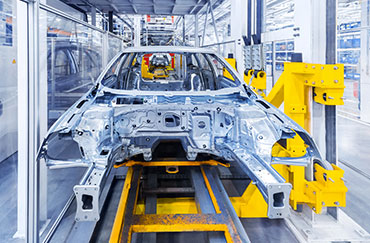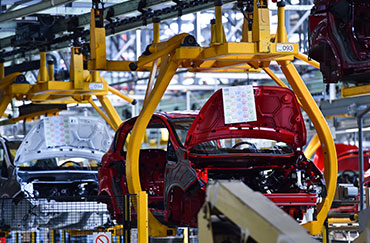ZERO DOWNTIME – How predictive maintenance is revolutionising automotive production
Richard Habering | 14. July 2021
In automotive production, the line never stops. On average, an engine comes off the assembly line every 14 seconds – during peak periods, more than 6,000 engines are produced every working day. The automotive industry also has very high standards for system precision. In a steady state, various production stations are harmonised with each other. Any damage affects the entire production line. To avoid unplanned downtime and system breakdowns, many German and international automotive factories are already using modern maintenance concepts with predictive maintenance.
In car body construction, processes are especially smooth. If a machine part stops, the entire production line ceases work. In order to keep a constant eye on the electrical cables and supply packages for the robots in rotating movement and linear movement on the seventh axis, igus has developed i.Sense, its condition monitoring solution . It provides information on the current operating status at all times, detects irregularities immediately, and proactively prevents unnecessary machine downtime.

In general, condition monitoring means regular or continuous monitoring of the machine’s condition, e.g. for wear. It is performed in pursuit of two goals: reliability and machine efficiency. If smart plastics are used for condition monitoring, they immediately report any unexpected operating states, switch off the system or sound an alarm. Automotive manufacturers use this function to minimise system failures and downtime:
- Detects machine status regularly or continuously
- Uses fast switch-off to avoid crashes
- Data recording with i.Sense modules
- Simple, efficient commissioning or retrofitting of existing systems
i.Cee follows i.Sense – the solution for predictive maintenance in automotive manufacture
The power train production line has high demands of machine reliability. The various stations, some of which have long routes, form a complex, highly dynamic system; any damage affects the entire production line. Ideally, production runs without disruptions, and shutdowns can be planned sensibly with the help of i.Cee, the smart plastics predictive maintenance solution .

The central element of the predictive maintenance system is the i.Cee software. Working with sensors on the energy chain, a plain bearing bush or a linear carriage, it transforms products deliverable from stock into smart products. This upgrade creates the capability of determining your igus products’ maximum service life and the perfect time for servicing. The software we provide and a few sensors transform standard products available from stock into a smart energy supply system or smart bearing technology in no time:
- Avoid expensive production stoppages
- Predict maintenance precisely
- Maximise the service life of the components you are using
- A simple step for integrating your system(s) into networked Industry 4.0 concepts
Final assembly provides the finishing touches in the production chain. But smooth processes are no less necessary here than at the beginning of production. Manipulators, which often assist people in manufacturing during this step, should be easy to move. Here, lightweight but tough energy chains made of polymer, are just right. Supporting rollers allow even long distances to be covered consistently in these applications.
OEM best practices impressively show the advantages of predictive maintenance
A practical example of a well-known OEM from southern Germany: a robot’s energy chain had previously been checked visually by the maintenance technician. The robot has six degrees of freedom and works 24 hours a day, seven days a week. Without smart technology, the chain was previously examined for wear every three months and replaced as necessary – that is, if there was visible damage. Breakage nevertheless often occurred within one of these cycles because the machine programmers made minimal changes or because minimal damage could not be detected with the naked eye. Sometimes nothing happened for many months at a time, but then the next quarter would have two incidents of major damage. Wear and defects on components depend on such a multitude of external influences that reliable forecasts can hardly be derived – especially in such highly complex production environments as in automotive manufacturing. smart plastics i.Cee introduces predictive maintenance to automotive manufacture in just a few steps.


